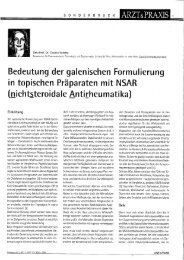Diclofenac Sodium 4% Spray Gel - cyathus.cz
Diclofenac Sodium 4% Spray Gel - cyathus.cz
Diclofenac Sodium 4% Spray Gel - cyathus.cz
Create successful ePaper yourself
Turn your PDF publications into a flip-book with our unique Google optimized e-Paper software.
PAR <strong>Diclofenac</strong> <strong>Sodium</strong> <strong>4%</strong> <strong>Spray</strong> <strong>Gel</strong><br />
UK/H/0562-3/001/E01<br />
Eight subjects underwent the single dose cross-over treatment (60 mg diclofenac<br />
sodium or its equivalent on the paravertebral skin area), while four were administered<br />
the equivalent of 15 mg diclofenac sodium qds in addition from days 2 to 4 in the<br />
multiple dose cross-over part of the investigation.<br />
Results. Regarding skin tolerability, four reports of low grade erythema were made<br />
(two subjects after completing day 4 of the test product and two during or following<br />
single administration of the reference product).<br />
Plasma samples 30 minutes after administration showed diclofenac concentrations of<br />
between 0.17 and 6.52 ng/ml after the test product and between 0.77 and 4.65 ng/ml<br />
after the reference gel. After this transdermal diffusion, the initial peak concentrations<br />
occurred between 0.5 and 1.5 hours, followed by a decrease of some 50% and then a<br />
continuous increase to C max at around 24 hours after administration.<br />
The plasma levels of diclofenac were initially greater for the reference product but<br />
this difference did not appear to be maintained beyond the third day when both<br />
products were administered qds.<br />
In this small population sample, the steady state plasma concentrations for both<br />
products were of the order of 2ng/ml – and it is reported that the effective plasma<br />
level for therapeutic effects is around 50ng/ml.<br />
Study Summary [B]. The second pharmacokinetic study included in this dossier is<br />
an open, single-centre, two period, non-randomised comparison of the relative<br />
bioavailability in subcutaneous and muscular tissue, versus plasma of the topicallyapplied<br />
test product and an orally administered formulation of diclofenac. Equivalent<br />
doses were tested on 12 male subjects.<br />
Endpoints included the bioavailability differences and secondarily, changes in<br />
laboratory standard tests, basic safety information and local tolerability.<br />
Results. Relative bioavailability (Treatment A – Topical vs Treatment B-Oral of<br />
diclofenac at steady state based upon AUC ∝ (Geometric mean and 95% confidence<br />
intervals.<br />
Plasma 2.23% [1.55% - 3.20%]<br />
Subcutaneous tissue (thigh) 32<strong>4%</strong> [232% - 453%]<br />
Muscular Tissue (thigh) 209% [130% - 337%]<br />
Safety data. There were no significant adverse findings in this small sample.<br />
Conclusion. The results support the claim that this spray-gel preparation permeates<br />
through the skin to the target tissues in significantly greater amounts than is<br />
distributed to the systemic circulation.<br />
27



